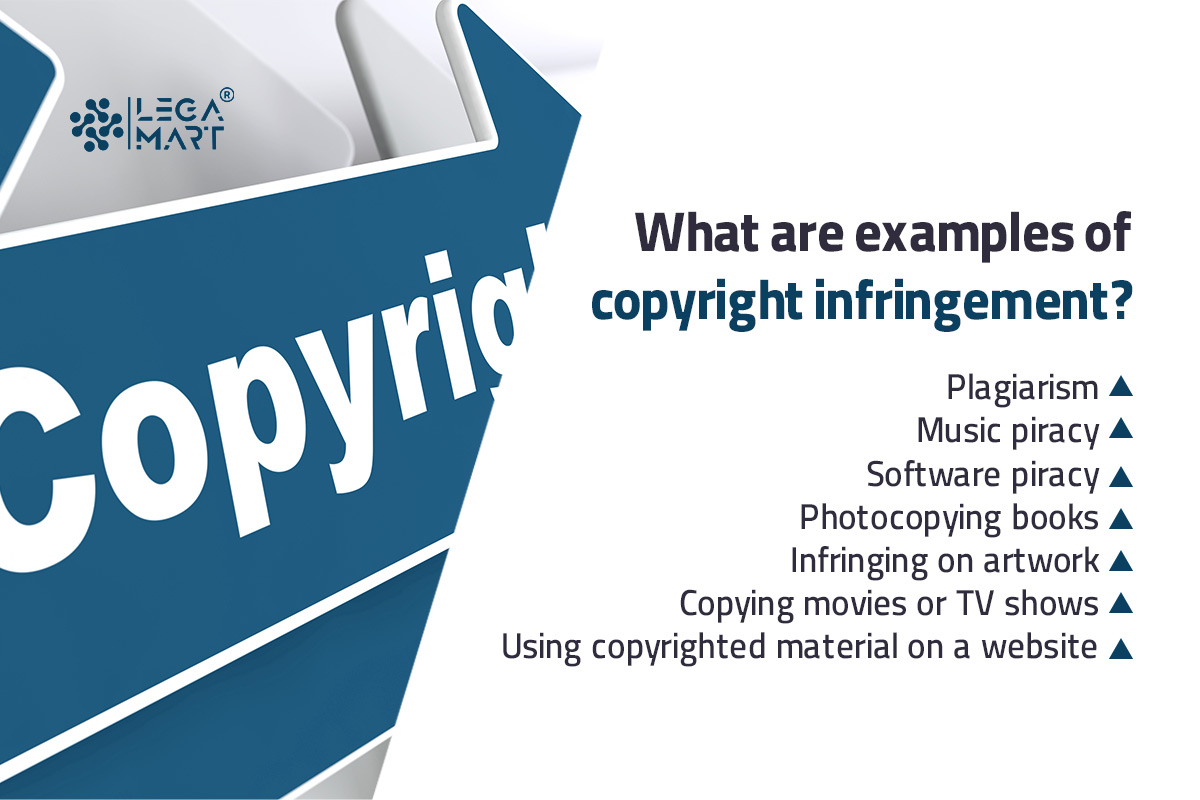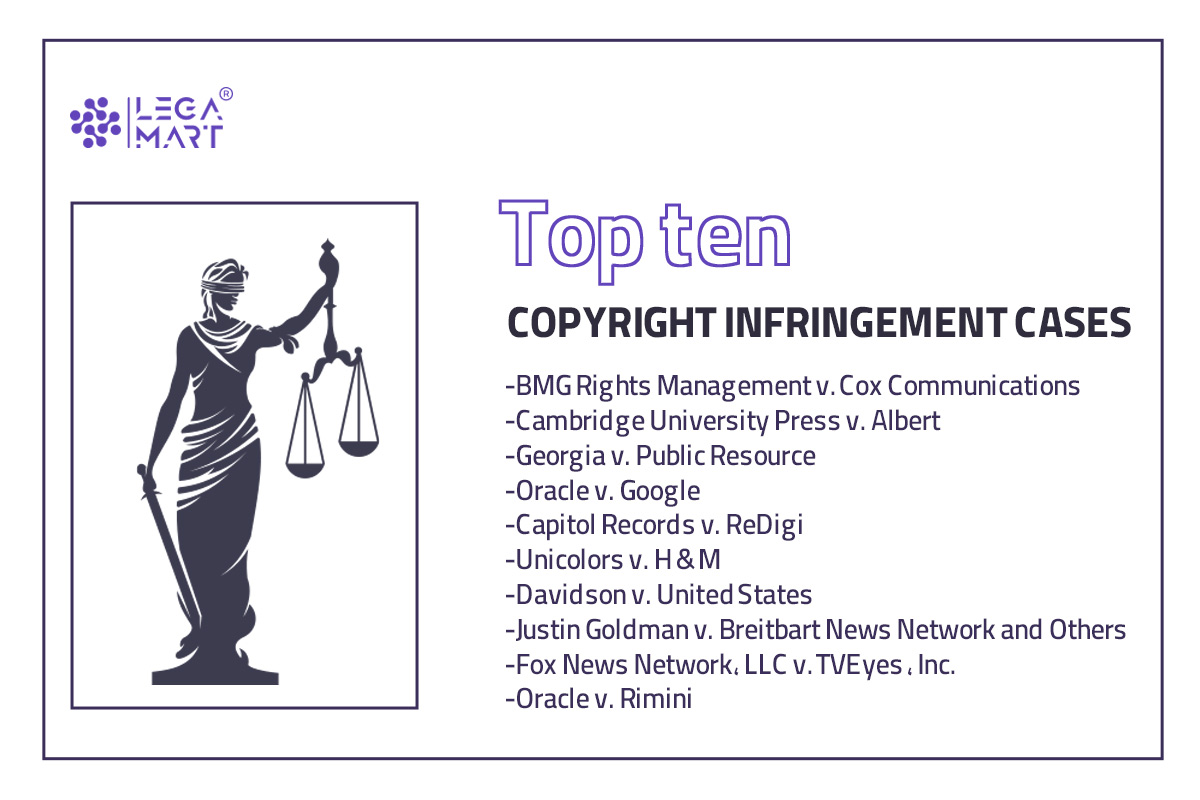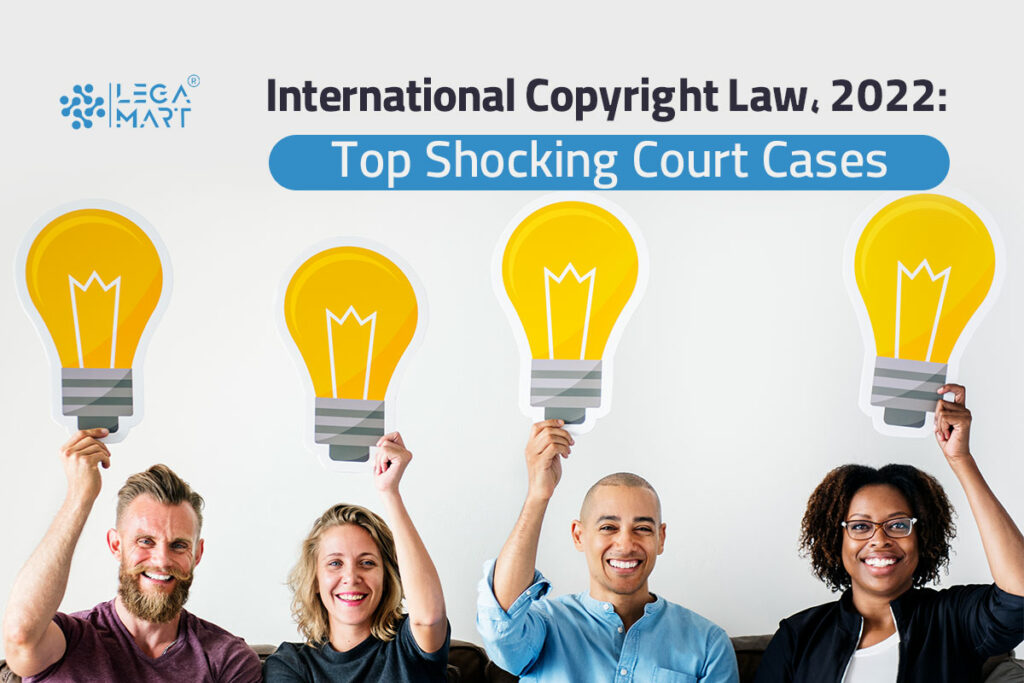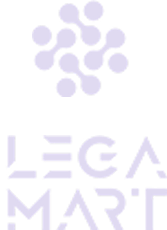- Introduction
- What is copyright?
- What is Copyright infringement?
- What are examples of copyright infringement?
- Copyright and Fair Use
- Recent Copyright Court Case on Fair Use
- International Copyright Infringement
- International Copyright Conventions
- Top Ten Copyright Infringement Cases
- International Copyright Law infringement court cases FAQ
- Final words: International Copyright Issues
International copyright law, a core aspect of Cross-Border & International Law, has been one of the major issues in the last decade. Your novel, “Sweet Revenge,” is about a twenty-five-year-old bitter woman seeking revenge on her narcissistic ex, who has custody of their daughter. Three months after it is published and copyrighted in the United States, it sold over ten million copies and climbed to the top of the list of bestsellers in the New York Times. As a famous author, you are invited to a literary festival being held in South Africa.
You visit one of the many book vendors to purchase a copy of “Long Walk to Freedom” by Nelson Mandela. Stacked next to Mandela’s title are fifty copies of “Sweet Revenge,” published by an obscure publishing company you have never heard of and most certainly did not submit your manuscript to.
You know that the company has infringed on your copyrights by publishing your work without your permission. But what sort of copyright infringement is that? National or international?
In this article, we will answer your question and provide similar real-life cases of copyright infringement that will help you tackle such scenarios in the future.
Introduction
International copyright law top court cases refer to landmark cases that have shaped the field of copyright law and set legal precedents in countries worldwide. These cases often involve disputes between creators, copyright holders, and users of creative works, and they address issues such as fair use, the scope of copyright protection, and the balance between the rights of copyright holders and the public interest.
Some of the most significant international copyright law top court cases as discussed in this article include; -BMG Rights Management v. Cox Communications, Capitol Records v. ReDigi, Cambridge University Press v. Albert and Unicolors v. H & M. These cases have had a significant impact on the field of copyright law and have influenced the way that creators, other copyright owners and holders, and users of creative works navigate the complex legal landscape of copyright protection and infringement.
What is copyright?
Copyright is a legal right granted to the creator of an original work over their literary and artistic works, such as a book, song, film, or software. It gives the creator the exclusive right and rights to control the use and distribution of their work for a certain period, typically the creator’s lifetime plus several years after their death.
What is copyright infringement?
Copyright infringement occurs when someone uses, reproduces, or distributes a copyrighted work without the permission of the copyright owner, or in a way that goes beyond the scope of the permission granted. Examples of copyright include: Illegal download of music files; making modifications and reproducing of someone else’s creative work without making significant changes, and downloading licensed software from an unauthorized site.
What are examples of copyright infringement?

Examples of unauthorized use of someone’s copyright include:
Plagiarism: Presenting someone else’s work as your own, whether it is a written document, an image, or a video.
Music piracy: Downloading and distributing music without obtaining permission from the artist or record label.
Software piracy: Using and distributing software without obtaining permission from the software developer or company.
Photocopying books: Copying a book or portion of a book without obtaining permission from the publisher or author.
Infringing on artwork: Using or distributing artwork, illustrations, or photographs without obtaining permission from the artist or photographer. This type of content is often taken from social media channels like instagram, facebook.
Copying movies or TV shows: Distributing or reproducing movies, TV shows, or other audiovisual works without obtaining permission from the copyright holder.
Using copyrighted material on a website: Using text, images, videos, or other materials on a website without obtaining permission from the copyright holder.
Copyright and Fair Use
Fair use is a legal doctrine that allows certain limited uses of copyrighted works without the owner’s permission. The use must be for a transformative, non-commercial purpose, such as criticism, commentary, teaching or research. Fair use is determined on a case-by-case basis, and a court will consider the four factors of fair use analysis (purpose and character of the use, nature of the copyrighted work, amount and substantiality of the portion used, and effect on the potential market for or value of the copyrighted work) to determine if the use is fair.
Fair use is an exception to the copyright owner’s exclusive rights, while infringement violates those rights.
Recent Copyright Court Case on Fair Use
Andy Warhol Foundation v. Goldsmith
The central issue in this lawsuit was whether Andy Warhol’s use of Lynn Goldsmith’s photograph of Prince in a series of artworks violated Goldsmith’s copyright. The lawsuit involved an interpretation of the Copyright Act and the fair use doctrine.
Goldsmith claimed that Warhol’s use of her photograph was unfair and constituted an infringement under the copyright act. The Warhol Foundation argued that Warhol’s use of the photograph was transformative and fair. The court analyzed the four factors of fair use to determine whether Warhol’s use of the photograph was fair.
Finally, the court rejected the fair use allegations and court found that Warhol’s use of Goldsmith’s photograph was not a fair use but an infringement. This case highlights the importance of the fair use doctrine in copyright Act.
International Copyright Infringement
There is no such thing as an international copyright. This is because copyright issues are regulated by domestic laws. That is, their application is limited to the country in which they are issued. Therefore, copyright infringement is simply an infringement of someone’s copyright, using copyrighted work without the copyright owner’s permission. Copyrightable materials include literary works; pictures; portraits; sculptures; textiles and other designs; songs; software; radio and television programs.
It is a known fact that domestic copyright cases should be tried in accordance with domestic copyright laws. But, when a case of copyright infringement involves parties from different countries or actions that affect people worldwide, such as internet-related matters, the case will be decided using the copyright laws of the country where the trial court is located as international copyright conventions. As a result, it is related to international copyright law.
International Copyright Conventions
The leading international copyright convention is the Berne Convention for the Protection of Literary and Artistic Works, adopted in 1886. It sets out three fundamental principles and minimum standards for the protection of copyrightable works across the globe. Once a country signs the Berne Convention, your work will be eligible for the protective measures guaranteed under the convention, so if you want your artwork to be under the protection of the mentioned above convention, your country should be the contracting party of the Berne Convention.
As of 2020, 179 countries, including the United States, China, and Russia, had signed the treaty.
Other international copyright treaties include the Universal Copyright Convention, the World Intellectual Property Organization Copyright Treaty, and the Agreement on Trade-Related Aspects of Intellectual Property Rights (TRIPS). These agreements set out standards for copyright protection, such as minimum copyright terms, exclusive rights for copyright holders, and limitations on copyright protection.
International copyright laws and treaties also provide for the recognition of foreign copyrights in other countries, making it easier for creators to protect their works globally. Additionally, these agreements establish mechanisms for resolving copyright disputes between countries, ensuring that copyright holders are adequately protected in all jurisdictions.
Overall, international copyright laws and treaties are essential for protecting creative works and promoting cultural and economic exchange between countries.
Can a Supreme court or District Court Grant Summary Judgment on a Copyright infringement case?
Granting summary judgment in a copyright infringement case means that the court has made a decision without a trial based on the evidence presented in the case. It is normally granted when the court finds that there are no genuine disputes of material fact and that one party is entitled to judgment as a matter of any federal copyright law provision. However, not all cases will result in a summary judgment ruling.
In terms of copyright infringement, the supreme court or district court may grant summary judgment if the Copyright owner has proved that they own a valid copyright and the defendant copied the protected work. The copyright owner must also prove that the copied work was substantial enough to constitute infringement. If the defendant cannot provide evidence to dispute any of these elements, the court may grant judgment summarily in favour of the copyright owner.
Is there a recently decided case where the court ruled summary judgment in copyright infringement?
UMG Recordings, Inc. v. Vital Pharmaceuticals, Inc., 2022 WL 267033
In this case, the Southern District Court entered summary judgement where the plaintiffplaintiff was alleging copyright infringement. The judge found that the alleged infringement was based on direct copyright infringement claims, which was made against an energy drink company that posted videos to its TikTok accounts and the said videos contained unlicensed music.
The Southern District Court’s decision was based on the finding that various record companies and music publishers sued an energy drink and sports nutrition supplement company together with its chief executive officer for direct, contributory and vicarious infringement for posting videos that contained unlicensed sound recordings and musical compositions owned by the plaintiff to its TikTok account.
Both parties separately sued for summary judgment on the following;
a) The issue of liability for direct infringement of copyright, where the court awarded a partial judgment summarily on grounds that the plaintiff did not have sufficient ownership of the copyrights in the sound recordings. used.
b) Contributory and vicarious infringement of copyright, where the court denied summary judgment on grounds that the plaintiff failed to establish that the Executive officer received a direct financial benefit from the influencers’ direct infringement.
c) On the issue of liability for direct and for contributory and/or vicarious copyright infringement.
Top Ten Copyright Infringement Cases

BMG Rights Management v. Cox Communications
Here is the first case related to international copyright law. BMG Rights Management is a music publishing company that owns the copyrights of the songs it produces. Cox Communications is an internet service provider that provides a platform for its subscribers to stream and download music. In 2014, BMG filed a lawsuit against Cox for committing contributory copyright infringement by allowing its (Cox’s) subscribers to download and share BMG’s music without their permission.
The case was tried at the district court. Cox argued that it was entitled to a “safe harbor” defense under section 512 (a) of the Digital Millennium Copyright Act (DMCA). One of the provisions of the DMCA prohibits unauthorized people from downloading and sharing copyrighted digital content. Some of Cox’s subscribers repeatedly shared and downloaded BMG’s musical compositions, thus infringing on BMG’s copyrights and violating the DMCA.
But since Cox failed to deal with repeat infringers, the district court judge ruled that it wasn’t entitled to the “safe harbor” defense. Consequently, BMG won the case and was awarded damages of $25 million.
Cambridge University Press v. Albert
Officials of Georgia State University (GSU) copied excerpts from some books and digitally distributed them to their students for academic purposes. So the publishers of those books (Cambridge University Press, Oxford University Press and Sage Publications) sued GSU for infringing on their copyrights in seventy-four different instances within three academic terms in 2009. The matter was taken to the District Court. There, the judge analyzed the alleged seventy-four instances of copyright infringement. Eventually, the court ruled that only five of those instances were valid because the publishers failed to sue failed sue GSU the first twenty-six times the university allegedly infringed on their copyrights and the fair use defense applied in forty-three instances.
The fair use defense applies when the accused copies a part of the copyrighted work in order to criticize, comment on or parody it. In this case, GSU officials distributed those excerpts to the students for academic criticism. Therefore, the court issued an order preventing GSU from copying and distributing excerpts from the books in question in the future. When the publishers appealed to an appellate court, the district court’s judgment was reversed and the case was remanded on appeal.
Capitol Records v. ReDigi
As its name implies, Capitol Records is a company that specializes in recording and producing music. ReDigi was a digital marketplace for buying and selling music recordings obtained from various sources, including Capitol Records. Copyright laws required ReDigi to obtain a license from Capitol Records before commercializing those recordings. Since they didn’t have a license from Capitol, they were found liable for direct and contributory infringement of copyright.
Georgia v. Public Resource
Public Resource, a non-profit organization that aimed at making government records more accessible to the general public, scanned and uploaded the 2013 version of the Official Code of Georgia Annotated (OCGA) on its website. Georgia had paid a private publishing house to print copies of OCGA, which were sold to inhabitants of the state. Georgia also granted that private publisher full copyright which excluded any other body from printing or duplicating OCGA. When Public Resource uploaded the entire OCGA on its website and made it available to anyone who wanted it for free, Georgia sued the organization for copyright infringement. Public Resource argued that OCGA was a body of law and so could not be copyrighted.
The case was first tried in a federal court. There, the verdict was that OCGA was indeed copyrightable. When the second circuit court of appeal looked into the matter, the court of appeal decided that laws, including OCGA, are not protected by copyrights. This is because laws are enacted by legislators who are elected by the general public. Therefore, laws are public property and cannot be regarded as the creation of a private entity.
Oracle v. Google
Before the dispute began, Google tried to obtain a license to use an operating system named Java SE from Sun Microsystems Inc., the developers of the operating system. Unfortunately, Google was unable to procure the license. By and by, Oracle bought Sun and, by implication, the Java SE.
Meanwhile, Google was developing the now popular mobile device platform named Android, which was different from Java and a bit complex for programmers to understand. In order to make it easier for programmers to familiarize themselves with Android, Google incorporated over 11, 000 lines of code from Java SE and 37 API packages similar to the ones used in Java into Android.
Then Oracle brought charges against Google for infringing on its copyrights on Java SE. This case was eventually decided by the Supreme Court, which ruled that Google’s act of copying lines of code from Java SE amounted to fair use. Google won the court case and went away scot-free.
Unicolors v. H & M
Unicolors is a Canadian company that creates design patterns to be used on fabrics. It created 31 design patterns and applied for one copyright for all of them, instead of having a separate copyright for each design. The collection was called EH101.
H & M is a multinational clothing company headquartered in Sweden. In 2011, H & M started selling a jacket and skirt with a design pattern called Xue Xu. Unicolors claimed that Xue Xu was similar to EH101 and sued H & M to court.
In the district court, H & M argued that Unicolors’ copyright on EH101 was invalid because it used a single copyright for 31 designs, instead of separate copyrights for each one. Therefore, the lower court had awarded Unicolors $800,000 in damages. But when H & M appealed to the Ninth Circuit, the district court’s judgement was reversed.
Then Unicolors appealed to the Supreme Court, which ruled that Unicolors’ copyright was valid regardless of the inaccuracies in the application process.
Davidson v. United States
Davidson sculpted a replica of Lady Liberty but changed her face to resemble that of his grandmother and erected his replica in front of the New York-New York Hotel Casino in Las Vegas.
The United States Postal Office took a picture of Davidson’s statue and printed it on all the stamps they subsequently produced. They made $70 million in profits from the sales of those stamps.
Then Davidson sued the United States for infringing on his copyrights on the replica of Lady Liberty. The court ruled in his favour and awarded him over $3.5 million in damages.
Justin Goldman v. Breitbart News Network and Others
Goldman, a photographer, posted a photo of Tom Brady and Kevin Durant in East Hampton with other celebrities on his Snapchat story, speculating whether Brady was recruiting Durant for the Celtics.
As the picture went viral, some celebrities posted it on their Twitter handles, joining the speculation. Breitbart News Network and other websites then wrote blogs about Justin’s speculations. In those blogs, they embedded links to the picture, as displayed on Twitter, on their websites. Goldman sued them for willful infringement, arguing that they had displayed the picture without his permission. The court ruled in Goldman’s favor, stating that Breitbart News Network and other accused websites were liable for copyright infringement.
Fox News Network, LLC v. TVEyes, Inc.
TVEyes is an online media company. It records all of the content on about 1400 television and radio stations, including Fox News Channel and Fox Business Channel, and uploads the content on its database, which its subscribers could access for $500.
Fox News sued TVEyes for copyright infringement because TVEyes allowed its subscribers to download and share content obtained from Fox’s channels.
The court ruled in Fox’s favor and issued an injunction permanently prohibiting TVEyes from recording and uploading Fox’s content.
Oracle v. Rimini
Rimini competed with Oracle’s internal maintenance services by providing third-party maintenance services for Oracle’s software. Rimini downloaded software updates from Oracle’s website without Oracle’s permission in order to compete effectively, thus violating Oracle’s terms of use.
As a result, Oracle sued Rimini and when Rimini was found liable for infringement, the court awarded Oracle over $100 million in damages.
Frequently Asked Questions
What is the role of international copyright law in infringement cases?
International copyright law provides a framework for protecting copyrighted works across national borders. It sets out the basic principles for protecting copyright, including the exclusive rights of the copyright owner and the limitations and exceptions to those rights.
How can I protect my copyrighted works from infringement?
There are several steps that you can take to protect your copyrighted works from infringement, including registering your copyright, placing a copyright notice on your works, and monitoring the use of your works online. You may also want to consider working with a lawyer who specializes in copyright law to help you protect your rights.
What are the common punishment for infringing someone’s copyright?
Punishment for infringing someone’s copyright varies depending on the country and the severity of the infringement. However, some common punishments may include paying for damages to the copyright owner, or fines or imprisonment.
Final words: International Copyright Issues
In conclusion, international copyright law is an important framework for protecting intellectual property across national borders. To obtain legal protection for original creative works, it is important to register it with the copyright office. Therefore, it is essential for the copyright office to work together to enforce copyright law and prevent cross-border infringement. Additionally, it is important for copyright owners to take steps to protect their works from infringement, including registering their copyrights and monitoring the use of their works online.
With the advent of artificial intelligence and the internet as a medium of transmitting files and information, copyright issues are becoming more global. Please note that you shouldn’t rely on the court judgements in the cases listed above. Copyright issues differ from case to case, so it is best to consult an intellectual property attorney for personalized legal advice.
LegaMart is a global legal platform designed to connect individuals, startups, and businesses with qualified lawyers across jurisdictions. With a mission to simplify cross-border legal services, LegaMart provides users with access to a diverse network of vetted legal professionals who specialize in areas such as international law, corporate law, immigration, dispute resolution, and more.
By leveraging technology and user-friendly tools, LegaMart allows clients to search for lawyers by country, language, or legal expertise, submit their legal queries, and receive tailored legal solutions in a streamlined, efficient manner. The platform serves as a bridge between legal professionals and clients who need multilingual, multi-jurisdictional support — especially in today’s increasingly globalized legal landscape.
Whether you’re an entrepreneur launching a business abroad, an individual dealing with immigration paperwork, or a company navigating cross-border compliance, LegaMart aims to make legal help more accessible, transparent, and collaborative.




